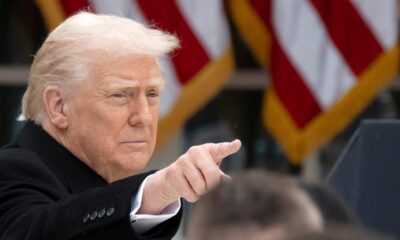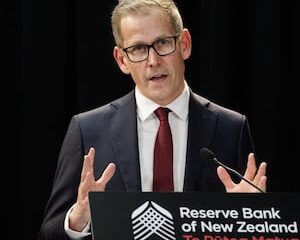Business
Gold Price Surges to Record High, Reflecting Global Tensions

The price of gold has reached a record high, breaking through $4,000 an ounce this week, marking a significant increase of over 50% since the beginning of 2023 and more than doubling in the past two years. This surge reflects a complex mix of global economic concerns, particularly regarding the United States.
Many factors contribute to this unprecedented rise in gold prices. Analysts point to escalating global debt levels, political instability, ongoing conflicts, and questionable monetary policies as key drivers. The recent boom in artificial intelligence, particularly following the launch of ChatGPT in late 2022, has also led to concerns about market sustainability, prompting investors to seek traditional safe havens like gold.
US Political and Economic Instability Fuels Gold Demand
At the heart of these uncertainties lies the United States. Under the administration of Donald Trump, the political landscape has been marked by erratic decisions, controversial cabinet appointments, and significant shifts in international relations. Trump’s trade wars have disrupted global trade, contributing to rising unemployment and inflation rates in the US, which in turn have raised concerns about stagflation—a situation characterized by stagnant economic growth and high inflation.
The Federal Reserve has faced pressure from Trump to lower interest rates, causing unease among foreign investors. The potential for a weakened US dollar, alongside the Fed’s recent decision to cut its policy rate by 25 basis points, has led many to question the stability of American monetary policy. As of September 30, 2022, US government debt stood at approximately $35.5 trillion, and it has since risen to about $38 trillion, reflecting a debt-to-GDP ratio of nearly 125%.
Governments worldwide are grappling with similar financial challenges. According to the International Monetary Fund, public sector debt across advanced economies is projected to exceed 110% of GDP by year-end 2023. In the first half of this year alone, global debt rose over $21 trillion, reaching a total of $338 trillion, as reported by the Institute of International Finance. This mounting debt has led to political turmoil in various countries, including France, which recently lost its fifth prime minister in three years amid efforts to address its own fiscal issues.
Global Economic Trends and Gold’s Safe Haven Status
With rising debt levels and economic instability, many countries are expected to adopt aggressive fiscal policies to stimulate growth. These measures often come with risks, including increased inflation and the devaluation of currencies. Central banks and investors are responding by accumulating gold as a safeguard against these uncertainties. The US dollar’s depreciation—down more than 10% against major currencies this year—has made gold even more appealing as a hedge.
The historical context of gold price surges reveals parallels with previous economic crises. The last significant rise in gold prices occurred in 1979, driven by high inflation and the instability of fiat currencies. The geopolitical climate at that time was similarly fraught, with events like the Islamic revolution in Iran and the Soviet invasion of Afghanistan contributing to global anxiety.
In recent years, the geopolitical landscape has been complicated by the conflict in Ukraine and tensions in the Middle East. The G7’s use of financial sanctions against Russia has prompted countries to reconsider their reliance on US-dollar-denominated assets. This shift has accelerated central bank purchases of gold, particularly in nations like China, which seek to mitigate exposure to potential financial sanctions.
The correlation between gold and other assets, such as Bitcoin, has also been noteworthy. Both are seen as hedges against inflation, and recent trends indicate that as investor risk appetite increases, so does interest in these alternative assets. The current dynamics suggest that gold will remain a vital component of investment strategies amid ongoing financial and political challenges.
In summary, the surge in gold prices to record levels is not merely a market anomaly but a reflection of deeper global issues. As economic uncertainties continue to mount, the demand for gold as a safe haven is likely to persist, reinforcing its status as a cornerstone of financial stability.
-

 World6 days ago
World6 days agoPrivate Funeral Held for Dean Field and His Three Children
-

 Top Stories1 week ago
Top Stories1 week agoFuneral Planned for Field Siblings After Tragic House Fire
-

 Sports3 months ago
Sports3 months agoNetball New Zealand Stands Down Dame Noeline Taurua for Series
-

 Entertainment3 months ago
Entertainment3 months agoTributes Pour In for Lachlan Rofe, Reality Star, Dead at 47
-

 Entertainment2 months ago
Entertainment2 months agoNew ‘Maverick’ Chaser Joins Beat the Chasers Season Finale
-

 Sports3 months ago
Sports3 months agoSilver Ferns Legend Laura Langman Criticizes Team’s Attitude
-

 Sports4 weeks ago
Sports4 weeks agoEli Katoa Rushed to Hospital After Sideline Incident During Match
-

 Politics2 months ago
Politics2 months agoNetball NZ Calls for Respect Amid Dame Taurua’s Standoff
-

 World2 weeks ago
World2 weeks agoInvestigation Underway in Tragic Sanson House Fire Involving Family
-

 Entertainment3 months ago
Entertainment3 months agoKhloe Kardashian Embraces Innovative Stem Cell Therapy in Mexico
-

 Sports4 weeks ago
Sports4 weeks agoJamie Melham Triumphs Over Husband Ben in Melbourne Cup Victory
-

 World4 months ago
World4 months agoPolice Arrest Multiple Individuals During Funeral for Zain Taikato-Fox





















